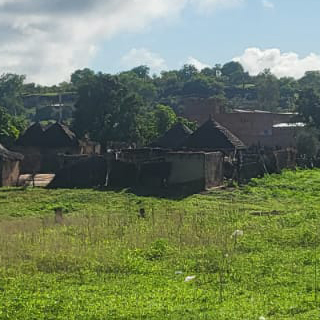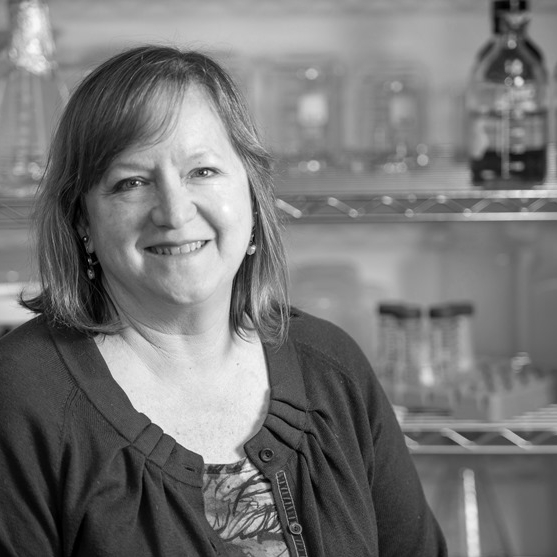Faculty & Staff
Elizabeth Putnam
Professor, Chair
Contact
- Office
- SB 395B
- Phone
- (406) 243-4794
- elizabeth.putnam@umontana.edu
- Curriculum Vitae
- View/Download CV
Personal Summary
Elizabeth Putnam is Professor of Molecular Genetics and Toxicology at the University of Montana. She currently serves as Chair of the Department of Biomedical and Pharmaceutical Sciences in the Skaggs School of Pharmacy, and is Acting Dean of the College of Health. After completing undergraduate work in Biochemistry at Rutgers College in New Brunswick, NJ, Elizabeth Putnam earned a Ph.D. in Biomedical Sciences from the University of Texas Graduate School of Biomedical Sciences in Houston. Following postdoctoral fellowships at M.D. Anderson Cancer Center and the University of Texas Medical School, she moved to the University of Montana in 2000. She is currently a tenured Professor.
Research Interests
Research in the Putnam laboratory focuses on the control of protein production related to lung fibrosis, using asbestos-caused fibrosis as a model system. We have identified SPARC, a matricellular protein involved in tissue repair, extracellular matrix (ECM) regulation, cellular proliferation, and cellular adhesion, as a candidate for involvement in the fibrosis that occurs after asbestos exposure. My laboratory is funded to explore the control of SPARC expression after asbestos exposure via RNA interference and thus fibrosis development as well.
My research efforts include outreach to rural and underserved communities, beginning with the community of Libby, Montana when I arrived at the University of Montana in 2000. My funding has included projects to provide comprehensive, collaborative and participatory initiatives that specifically increased community understanding of the interplay between genes and environment. We currently have funding to support our efforts to determine, in American Indian/Alaska Native populations, population-specific polymorphism frequencies in genes involved in drug metabolism and transport. The data obtained will enable physicians treating these patients to choose appropriate therapies with reduced potential for deleterious side effects. Another effort on this CBPR project is to develop culturally appropriate materials for genetic education of our partners.
Field of Study
Research in the Putnam laboratory focuses on the role of genetic variability in susceptibility to environmental insult.  Inherited differences in DNA sequence contribute to phenotypic variation, influencing an individual’s risk of disease and response to the environment.  Investigations into gene expression changes after exposure to environmental toxins provide insight into possible mechanisms of response, and the influence of genetic polymorphisms on expression of this response. Using the latest technologies for microarray analysis and automated DNA sequencing, these studies hold great promise for dissecting response to environmental toxins and identifying potential targets for therapeutic intervention.
Selected Publications
Putnam EA, Smartt AM, Brezinski M, Groves A, Schwanke C, and Pershouse MA. Histologic and gene expression changes after amphibole exposures in a mouse model. J Immunotox. In press, 2008.
Larson SJ, Putnam EA, Schwanke CM, and Pershouse MA. Potential surrogate markers for gamma-hydroxybutyrate administration may extend the detection window from 12 hours to 48 hours. J. Analytical Tox. 31:15-22, 2007.
Pfau JC, Pershouse MA, and Putnam EA. Conference Summary. Directions and Needs in Asbestos Research: New Insights. Inhalation Toxicology 18(12):921-925. 2006.
Pfau, JC, Sentissi, JJ, Weller, G, Putnam, EA.Assessment of autoimmune responses associated with asbestos exposure in Libby MT. Environ Health Perspect. Jan:113(1):25-30, 2005.
Wallis, DD, Putnam, EA, Cretoiu, JS, Carmical, SG, Cao S-N, Thomas G, and Milewicz, DM.Profibrillin maturation by human dermal fibroblasts:Proteolytic processing and molecular chaperones. J. Cellular Biochem, 90:641-652, 2003.
Gupta, PA*, Putnam, EA*,Carmical, SG, Kaitila, I, Steinmann, B, Child, A, Danesino, C, Chin, T, Metcalfe, K, Berry, S, Chen, E, Vincente-Delorme, C,Thong, M-K, Ades, L, And Milewicz, DM.(First two authors equal):FBN2 mutations in congenital contractural arachnodactyly:Delineation of the molecular pathogenesis and clinical phenotype. Human Mutation 19(1):39-48, 2002.
Guala A, Danesino C, Milewicz DM, Putnam EA, Franceschini P.The metacarpophalangeal profile in a family with congenital contractural arachnodactyly. Genet Couns 11:57-8, 2000.
Raghunath, M., Putnam, EA, Ritty, T. Hamstra, D., Park, E-S, Tschodrich-Rotter, M, Peters, R., Rehemtulla, A., and Milewicz, DM.Carboxy-terminal conversion of profibrillin to fibrillin at a basic site by PACE/furin-like activity required for incorporation in the matrix.J. Cell Science 112:1093-1100, 1999.
Hecht, J.T., Deere, M., Putnam, EA, Cole, W, Vertel, BM, Chen, H., Lawler, J.: Characterization of cartilage oligomeric matrix protein (COMP) in human normal and pseudoachondroplasia musculoskeletal tissues.Matrix Biol 17:269-278, 1998.
Park, E-S*, Putnam, EA*, Chitayat, D., Child, A., Milewicz, D.M. (First two authors equal):Clustering of FBN2 mutations in patients with congenital contractural arachnodactyly indicates an important role of the domains encoded by exos 24-34 during human development.Am J Med Genet. 78:350-355, 1998.
Putnam, EA,Aalfs, CM, Hennekam, CM, Milewicz, DM:Parental somatic and germ-line mosaicism for a FBN2 mutation and analysis of FBN2 transcript levels in dermal fibroblasts.J Med Genet. 60: 818-827, 1997.
Putnam, EA, Cho, M. Zinn, AB Towbin, JA, Byers, PH, Milewicz, DM:Delineation of the Marfan phenotype associated with mutations in exons 23 through 32 of the FBN1 gene.Am J Med Genet . 62:233-242, 1996.
Putnam, EA, Zhang, H, Ramirez, F, Milewicz, DM, Fibrillin-2 (FBN2) mutations result in the Marfan-like disorder, congenital contractural arachnodactyly.Nature Genetics 11(4):456-468, 1995.
Horton, WA, Machado, MA, Ellard, J, Campbell, D, Putnam, EA, Aulthouse, AL, Sun, X, Sandell, LJ:An experimental model of human chondrocyte differentiation.Progress in Clinical and Biological Research. 383B:533-540, 1993.
Putnam, EA, Yen, N, Gallick, GE, Steck, PA, Fang, K, Akpakip B, Gazdar, AF, Roth, JA: Autocrine growth stimulation by transforming growth factor-? in human non-small cell lung cancer.Surgical Oncol. 1:49-60, 1992.
Schneider, PM, Hung, M-C, Ames, RS, Putnam, EA, Akpakip, B. Roth, JA:A novel alteration in the epidermal growth factor receptor gene is frequently detected in human non-small cell lung cancer.Lung Cancer. 6:65-72, 1990.
Publications
Pershouse MA, Smartt AM, Schwanke C and Putnam EA. Differences in gene expression profiles from asbestos-treated SPARC-null and wild type mouse lungs. Genomics 94(2):101-9, 2009.
Smartt AM, Brezinski M, Trapkus M, Gardner D and Putnam EA. Collagen accumulation over time in the murine lung after exposure to crocidolite asbestos or Libby amphibole. EnvironToxicol, 25(1):68-76. 2010.
Marchand LS, St-Hilaire S, Putnam EA, Pfau JC, Anti-Mesothelial Cell and Anti-Nuclear Autoantibodies Associated with Pleural Disease In Libby MT. Tox Letters. 2011, DOI 10.1016/j.toxlet.2011.10.024.
Yoo C, Brilz EM, Wilcox M, Pershouse MA, Putnam EA. Gene Pathways Discovery in Asbestos-Related Diseases using Local Causal Discovery Algorithm. Communications in Statistics - Simulation and Computation, 41:10, 1840-1859. 2012.
Fohner A, Muzquiz LI, Austin MA, Gaedigk A, Gordon A, Thornton T, Rieder MJ, Pershouse MA, Putnam EA, Howlett K, Beatty P, Thummel KE, Woodahl EL. Pharmacogenetics in American Indian Populations: Analysis of CYP2D6, CYP3A4, CYP3A5, and CYP2C9 in the Confederated Salish and Kootenai Tribes. Pharmacogenetics and Genomics, 23(8):403-14. 2013.
Morales CT, Muzquiz LI, Howlett K, Azure B, Bodnar B, Finley V, Incashola T, Mathias C, Laukes C, Beatty P, Burke W, Pershouse MA, Putnam EA, Trinidad SB, James R, Woodahl EL. Partnership with the Confederated Salish and Kootenai Tribes: Establishing an advisory committee for pharmacogenetic research. Progress in Community Health Partnerships: Research, Education and Action. 10(2):173-83. 2016.
Devin Hunt, Megan Branson, Victoria Gifford, Elizabeth Putnam, Mark Pershouse. (2020) Omics Resources. Chapter 42 from Information Resources in Toxicology (5th Edition) Edited by Phil Wexler, Asish Mohapatra, Antoinette Hayes, Sol Bobst, Steven Gilbert, and Sara Humes, National Library of Medicine. Published by Elsevier.
Megan Branson, Devin Hunt, Elizabeth Putnam, Mark Pershouse. (2020) Target Sites: Immune, Chapter 55 from Information Resources in Toxicology (5th Edition) Edited by Phil Wexler, Asish Mohapatra, Antoinette Hayes, Sol Bobst, Steven Gilbert, and Sara Humes, National Library of Medicine. Published by Elsevier.
Devin Hunt, Megan Branson, Elizabeth Putnam, Mark Pershouse. (2020) Molecular, Cellular, and Biochemical Toxicology, Chapter 38 from Information Resources in Toxicology (5th Edition) Edited by Phil Wexler, Asish Mohapatra, Antoinette Hayes, Sol Bobst, Steven Gilbert, and Sara Humes, National Library of Medicine. Published by Elsevier.
Devin Hunt, Megan Branson, Elizabeth Putnam, Mark Pershouse. (2020) Toxicoinformatics Today, Chapter 4 from Information Resources in Toxicology (5th Edition) Edited by Phil Wexler, Asish Mohapatra, Antoinette Hayes, Sol Bobst, Steven Gilbert, and Sara Humes, National Library of Medicine. Published by Elsevier.
Devin Hunt, Megan Branson, Elizabeth Putnam, Mark Pershouse. (2020) Development of Toxicoinformatics, Chapter 3 from Information Resources in Toxicology (5th Edition) Edited by Phil Wexler, Asish Mohapatra, Antoinette Hayes, Sol Bobst, Steven Gilbert, and Sara Humes, National Library of Medicine. Published by Elsevier.

